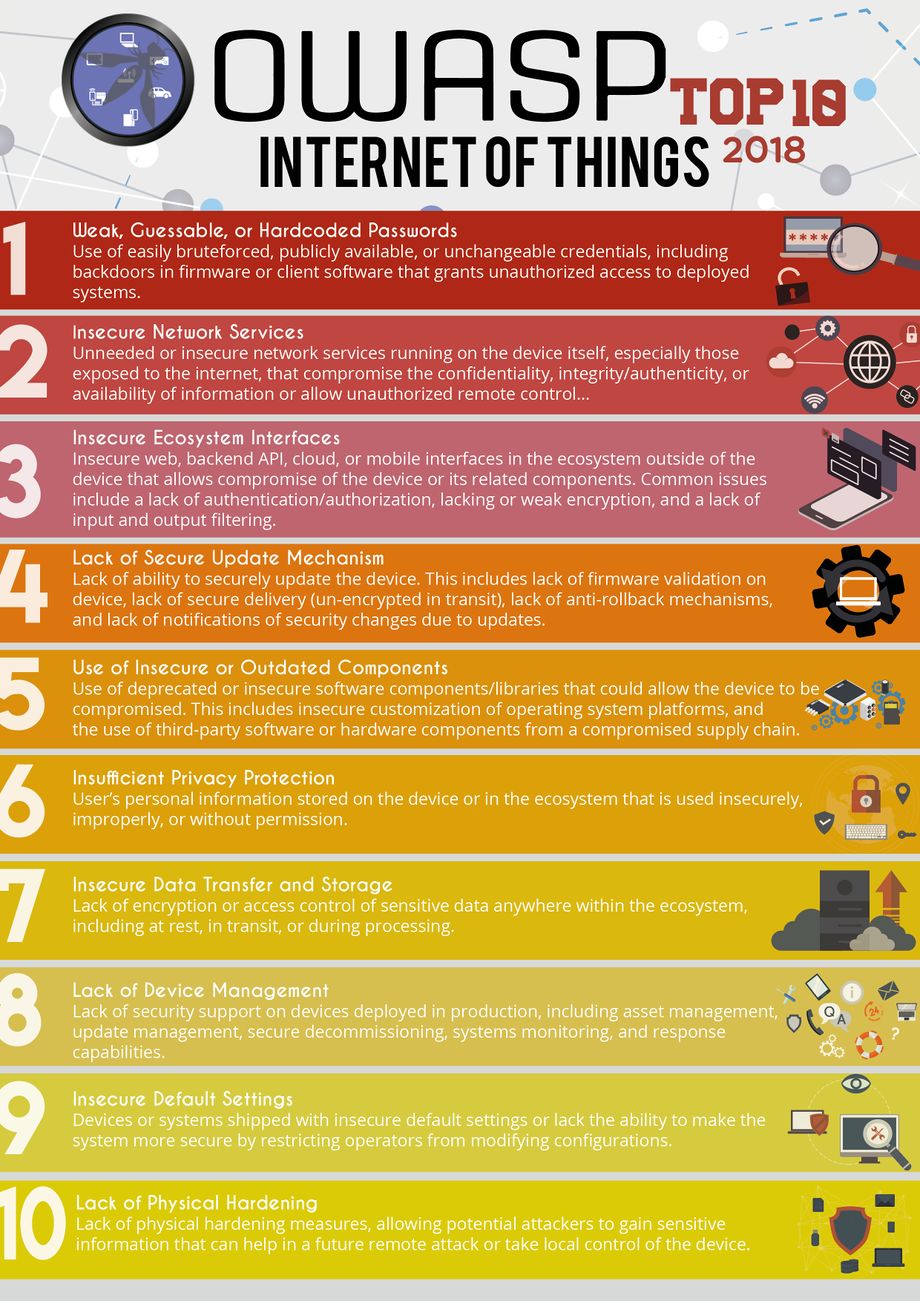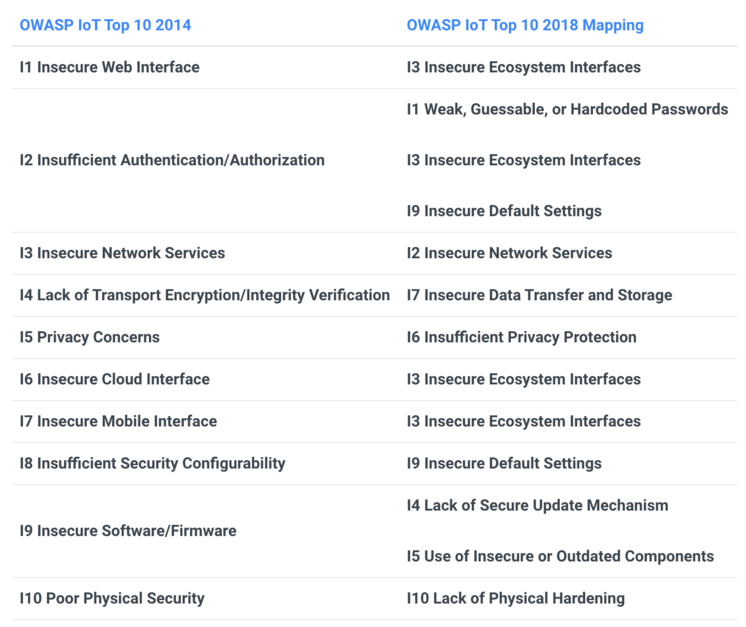This site is the archived OWASP Foundation Wiki and is no longer accepting Account Requests.
To view the new OWASP Foundation website, please visit https://owasp.org
Difference between revisions of "OWASP Internet of Things Project"
From OWASP
Aaron.guzman (talk | contribs) (→Medical Device Testing) (Tag: Visual edit) |
Aaron.guzman (talk | contribs) (FSTM) (Tag: Visual edit) |
||
| Line 1,079: | Line 1,079: | ||
* [https://github.com/scriptingxss/IoTGoat OWASP IoTGoat] | * [https://github.com/scriptingxss/IoTGoat OWASP IoTGoat] | ||
|- | |- | ||
| + | | | ||
| + | |}{{Social Media Links}} | ||
| + | |||
| + | | style="padding-left:25px;width:300px;border-right: 1px dotted gray;padding-right:25px;" valign="top" | | ||
| + | |||
| + | == What is the Firmware Analysis Project? == | ||
| + | |||
| + | The Firmware Analysis Project provides: | ||
| + | |||
| + | * Security testing guidance for vulnerabilities in the "Device Firmware" attack surface | ||
| + | * Steps for extracting file systems from various firmware files | ||
| + | * Guidance on searching a file systems for sensitive of interesting data | ||
| + | * Information on static analysis of firmware contents | ||
| + | * Information on dynamic analysis of emulated services (e.g. web admin interface) | ||
| + | * Testing tool links | ||
| + | * A site for pulling together existing information on firmware analysis | ||
| + | |||
| + | == Project Leaders == | ||
| + | |||
| + | * Craig Smith | ||
| + | |||
| + | == Related Projects == | ||
| + | |||
| + | * [[OWASP_Mobile_Security_Project|OWASP Mobile Security]] | ||
| + | * [[OWASP_Top_Ten_Project|OWASP Web Top 10]] | ||
| + | * [https://www.owasp.org/index.php/OWASP_Embedded_Application_Security OWASP Embedded Application Security Project] | ||
| + | |||
| + | == Collaboration == | ||
| + | [https://owasp-iot-security.slack.com The Slack Channel] | ||
| + | |||
| + | == Resources == | ||
| + | * [https://www.owasp.org/index.php/IoT_Firmware_Analysis IoT Firmware Analysis Primer] | ||
| + | * [https://otalliance.org/initiatives/internet-things Online Trust Alliance - Internet of Things] | ||
| + | * [https://people.debian.org/~aurel32/qemu/ Pre-compiled QEMU images] | ||
| + | * [https://code.google.com/archive/p/firmware-mod-kit/ Firmware Modification Kit] | ||
| + | * [https://craigsmith.net/episode-11-1-firmware-extraction/ Short Firmware Extraction Video] | ||
| + | * [https://craigsmith.net/episode-12-1-firmware-emulation-with-qemu/ Firmware Emulation with QEMU] | ||
| + | * [https://craigsmith.net/episode-18-1-file-extraction-from-network-capture/ File Extraction from Network Capture] | ||
| + | |||
| + | == News and Events == | ||
| + | * Coming Soon | ||
| + | |||
|} | |} | ||
= Firmware Security Testing Methodology = | = Firmware Security Testing Methodology = | ||
[[File:OWASP_Project_Header.jpg|link=]] | [[File:OWASP_Project_Header.jpg|link=]] | ||
| + | |||
| + | {| style="padding: 0;margin:0;margin-top:10px;text-align:left;" |- | ||
| + | | style="border-right: 1px dotted gray;padding-right:25px;" valign="top" | | ||
== Firmware Security Testing Methodology == | == Firmware Security Testing Methodology == | ||
| + | |||
The Firmware Security Testing Methodology (FSTM) is composed of nine stages tailored to enable security researchers, software developers, consultants, hobbyists, and Information Security professionals with conducting firmware security assessments. | The Firmware Security Testing Methodology (FSTM) is composed of nine stages tailored to enable security researchers, software developers, consultants, hobbyists, and Information Security professionals with conducting firmware security assessments. | ||
| Line 1,095: | Line 1,141: | ||
|- | |- | ||
|2. Obtaining firmware | |2. Obtaining firmware | ||
| − | |Attain | + | |Attain firmware using one or more of the proposed methods listed |
|- | |- | ||
|3. Analyzing firmware | |3. Analyzing firmware | ||
| Line 1,101: | Line 1,147: | ||
|- | |- | ||
|4. Extracting the filesystem | |4. Extracting the filesystem | ||
| − | |Carve | + | |Carve filesystem contents from the target firmware |
|- | |- | ||
|5. Analyzing filesystem contents | |5. Analyzing filesystem contents | ||
| Line 1,107: | Line 1,153: | ||
|- | |- | ||
|6. Emulating firmware | |6. Emulating firmware | ||
| − | |Emulate | + | |Emulate firmware files and components |
|- | |- | ||
|7. Dynamic analysis | |7. Dynamic analysis | ||
| Line 1,113: | Line 1,159: | ||
|- | |- | ||
|8. Runtime analysis | |8. Runtime analysis | ||
| − | |Analyze | + | |Analyze compiled binaries during device runtime |
|- | |- | ||
|9. Binary Exploitation | |9. Binary Exploitation | ||
|Exploit identified vulnerabilities discovered in previous stages to attain root and/or code execution | |Exploit identified vulnerabilities discovered in previous stages to attain root and/or code execution | ||
| − | |} | + | |}The full methodology release can be downloaded via the following TBD. |
| − | The full{{Social Media Links}} | + | |
| + | {{Social Media Links}} | ||
| style="padding-left:25px;width:300px;border-right: 1px dotted gray;padding-right:25px;" valign="top" | | | style="padding-left:25px;width:300px;border-right: 1px dotted gray;padding-right:25px;" valign="top" | | ||
| − | == What is the Firmware | + | == What is the Firmware Security Testing Methodology == |
| − | The Firmware | + | The Firmware Security Testing Methodology Project provides: |
| − | * | + | *Attack walkthroughs |
| − | * | + | *Tool usage examples |
| − | * | + | *Screenshots |
| − | * | + | *Companion virtual machine preloaded with tools (EmbedOS) - <nowiki>https://github.com/scriptingxss/EmbedOS</nowiki> |
| − | |||
| − | |||
| − | |||
== Project Leaders == | == Project Leaders == | ||
| − | * | + | * Aaron Guzman |
| − | |||
| − | |||
| − | + | == Quick Download == | |
| − | + | * TBD | |
| − | |||
| − | |||
| − | |||
| − | |||
| − | |||
| − | |||
| − | |||
| − | |||
| − | |||
| − | |||
| − | |||
| − | |||
| − | |||
| − | |||
| − | == | ||
| − | * | ||
|} | |} | ||
Revision as of 14:49, 31 October 2019





